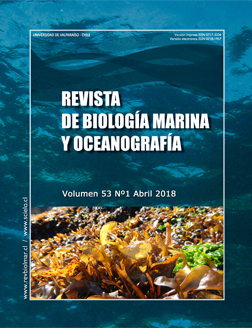Use of rocky shore intertidal organisms as bioindicators of coseismic continental deformation in south central Chile
DOI:
https://doi.org/10.4067/S0718-19572018000100061Keywords:
Continental uplift, Benthic organisms, subsidenceAbstract
On February 27, 2010, the south central coast of Chile (ca., 34-39°S) was affected by an earthquake magnitude Mw= 8,8, with the epicenter located offshore Cobquecura (ca., 36.29°S). This earthquake originated continental uplift on that coastal areas closer to the trench between the Nazca and South American tectonic plates (i.e., Peninsula de Arauco and Isla Santa María) and subsidence along coastal areas located further north of that (the coast of the Maule Region), as well as in continental zones ordered in a west - east axis. In this study we tested the hypothesis that independent of the taxonomic group, the rocky shore sessile benthic organisms can be used as indicators of continental uplift. The methodology involved measurements of heights upper of distributional bands above the low tide level at the coast affected by the earthquake. The results show that the calcareous crustose algae Lithothamnium sp., the mytilid bivalve Perumytilus purpuratus and the macroalgae Mazzaella laminarioides and Lessonia spicata, are benthonic useful organisms to describe continental uplift, due to the fact that their vertical distributions after the earthquake follow the coastal deformation observed in the field. This allow to suggest that in studies aimed to evaluate this tectonic processes, more than a single species must be used in order to gain a full view of that along gradients of continental deformation. This due to the fact that a significant number of the benthic species of the rocky shore do not have continuous distribution; thus, to use a single species may well result in conclusions with low level of generalizations.
Downloads
Downloads
Published
How to Cite
Issue
Section
License
• Los autores que publican en la RBMO transfieren sus derechos de publicación a la Universidad de Valparaíso, conservando los derechos de propiedad intelectual para difundir ampliamente el artículo y la revista en cualquier formato.
• La RBMO autoriza el uso de figuras, tablas y extractos breves de su colección de manuscritos, en trabajos científicos y educacionales, siempre que se incluya la fuente de información.





